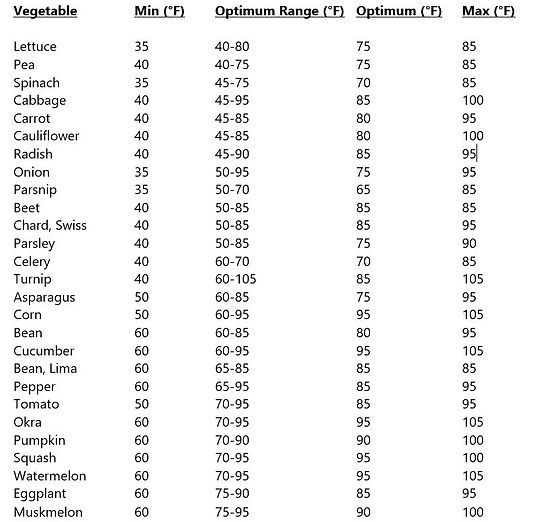
Gardening Articles
Lazy-Man's Fall Garden
by Betty Jo Page
Each year I encourage a lazy-man’s fall garden by allowing some plants to bloom and drop their seeds in my garden. I even take the dried stalks with seed heads on them and, using the stalks like a wand, I spread the seeds around by waving the stalks where I want the seeds to grow. With this method I distribute several kinds of lettuce, spinach, dill, mustard, borage, marigolds, calendula, and parsley.
After doing this for several years I realized that certain ones came up earlier than others. Then I ran into a seed temperature preference chart (see below) that explained why I always saw spinach and lettuce first, with marigolds and borage much later. Now I realize that when I see the spinach seedlings popping up, then I can plant the other seeds in the same temperature range for quicker sprouting. The lettuce and spinach are in the low-Optimum range of 40 and 45 degrees. I should try finding ones in the higher low-Optimum ranges that will also survive fall planting.
However, planting a fall garden means getting garden beds prepared in the fall. Often there are still crops growing in most of the beds, which presents a problem for keeping things organized. I just find it easier to allow my self-planted seedlings to sprout, then moving them to where I want them.
Sometimes the lettuce actually sprouts in the fall, so I tuck some mulch around them for protection. These babies actually give me lettuce at least three weeks earlier than spring sprouted plants. Parsley and mustard can also sprout in the fall to survive the winter and grow again.
Soil temperatures should be taken by inserting a soil thermometer 3 to 4 inches deep into the soil surface and noting temperature. Soil thermometers are available from garden centers, feed and seed stores, and from many garden supply catalogs. Soil temperatures should be consistent for several days before seeds are sown to ensure that the seeds are being exposed to optimal temperatures for germination. www.aces.edu
Soil Temperature Conditions for Vegetable Seed Germination
Joseph Kemble, Extension Horticulturist, Associate Professor, Horticulture, Auburn University; and Mary Beth Musgrove, former Extension Associate.
